Currency Manipulation: Strategies, Examples, and Global Implications
VerifiedAdded on 2019/10/01
|6
|2495
|207
Essay
AI Summary
This essay delves into the multifaceted topic of currency manipulation, examining its definition, objectives, and various strategies employed by governments and central banks. It explores the reasons behind currency interventions, such as regulating inflation, improving exports, boosting economic growth, and addressing trade deficits. The essay outlines different intervention policies, including sterilized and non-sterilized interventions, and provides real-world examples like the actions of the Swiss National Bank, China, and Japan. It further analyzes the consequences of currency manipulation, including the potential for increased debt burdens and negative impacts on international trade, particularly in the context of trade imbalances and disputes. The essay concludes by emphasizing the complexities and global implications of currency manipulation in the modern economic landscape. The content is contributed by a student to be published on the website Desklib, which provides all the necessary AI based study tools for students.

Blog Writing
Paraphrase This Document
Need a fresh take? Get an instant paraphrase of this document with our AI Paraphraser
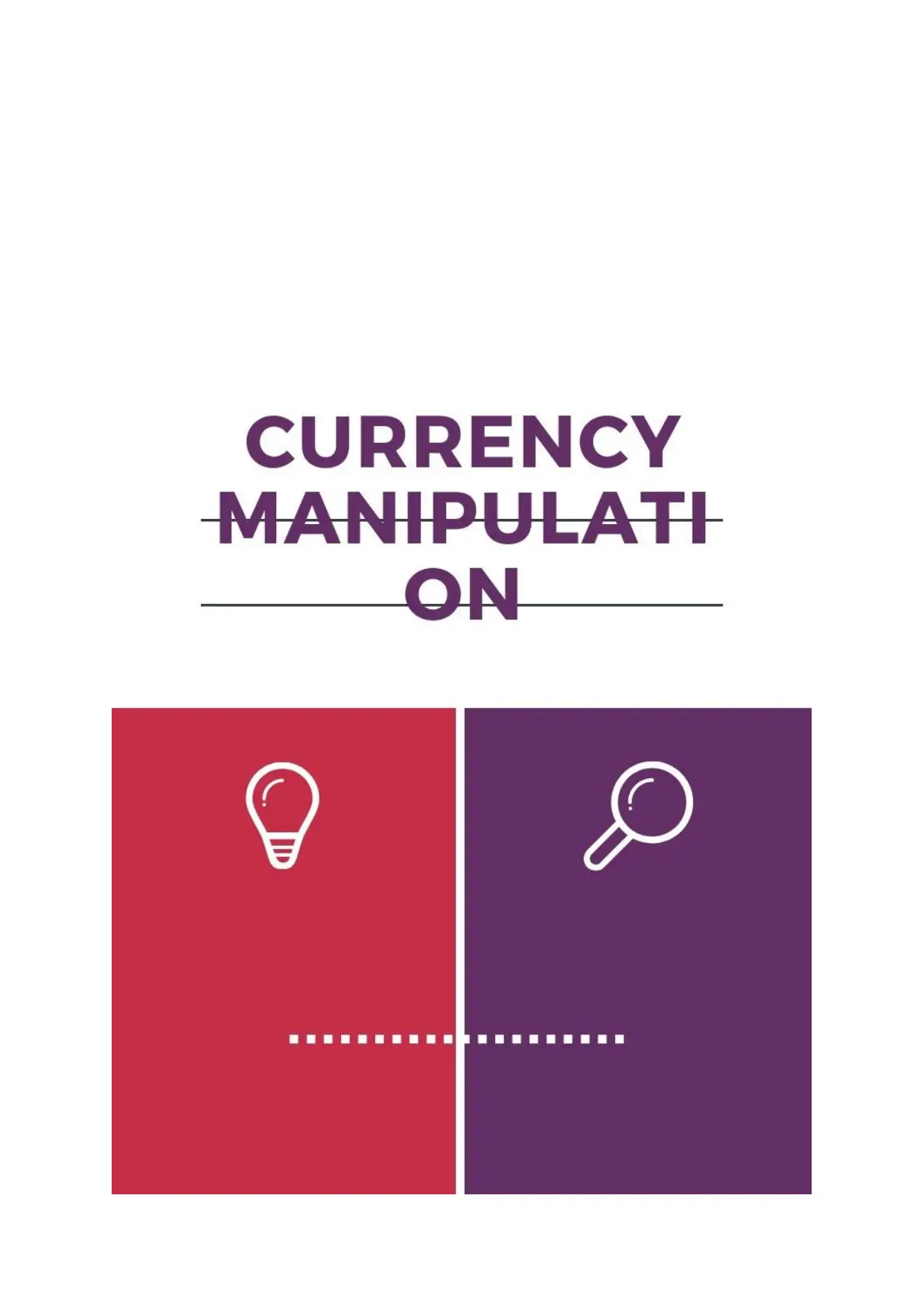
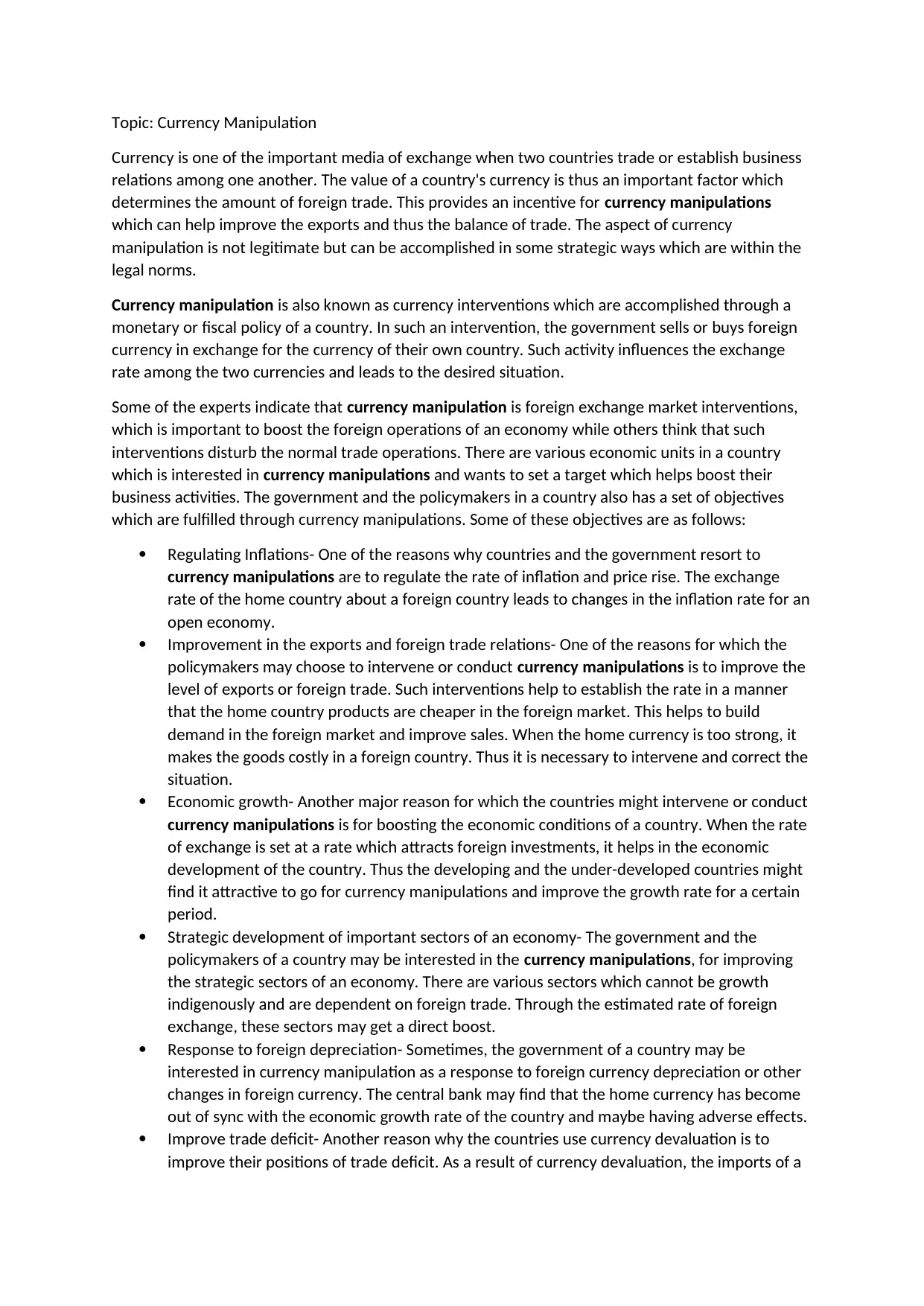
Topic: Currency Manipulation
Currency is one of the important media of exchange when two countries trade or establish business
relations among one another. The value of a country's currency is thus an important factor which
determines the amount of foreign trade. This provides an incentive for currency manipulations
which can help improve the exports and thus the balance of trade. The aspect of currency
manipulation is not legitimate but can be accomplished in some strategic ways which are within the
legal norms.
Currency manipulation is also known as currency interventions which are accomplished through a
monetary or fiscal policy of a country. In such an intervention, the government sells or buys foreign
currency in exchange for the currency of their own country. Such activity influences the exchange
rate among the two currencies and leads to the desired situation.
Some of the experts indicate that currency manipulation is foreign exchange market interventions,
which is important to boost the foreign operations of an economy while others think that such
interventions disturb the normal trade operations. There are various economic units in a country
which is interested in currency manipulations and wants to set a target which helps boost their
business activities. The government and the policymakers in a country also has a set of objectives
which are fulfilled through currency manipulations. Some of these objectives are as follows:
Regulating Inflations- One of the reasons why countries and the government resort to
currency manipulations are to regulate the rate of inflation and price rise. The exchange
rate of the home country about a foreign country leads to changes in the inflation rate for an
open economy.
Improvement in the exports and foreign trade relations- One of the reasons for which the
policymakers may choose to intervene or conduct currency manipulations is to improve the
level of exports or foreign trade. Such interventions help to establish the rate in a manner
that the home country products are cheaper in the foreign market. This helps to build
demand in the foreign market and improve sales. When the home currency is too strong, it
makes the goods costly in a foreign country. Thus it is necessary to intervene and correct the
situation.
Economic growth- Another major reason for which the countries might intervene or conduct
currency manipulations is for boosting the economic conditions of a country. When the rate
of exchange is set at a rate which attracts foreign investments, it helps in the economic
development of the country. Thus the developing and the under-developed countries might
find it attractive to go for currency manipulations and improve the growth rate for a certain
period.
Strategic development of important sectors of an economy- The government and the
policymakers of a country may be interested in the currency manipulations, for improving
the strategic sectors of an economy. There are various sectors which cannot be growth
indigenously and are dependent on foreign trade. Through the estimated rate of foreign
exchange, these sectors may get a direct boost.
Response to foreign depreciation- Sometimes, the government of a country may be
interested in currency manipulation as a response to foreign currency depreciation or other
changes in foreign currency. The central bank may find that the home currency has become
out of sync with the economic growth rate of the country and maybe having adverse effects.
Improve trade deficit- Another reason why the countries use currency devaluation is to
improve their positions of trade deficit. As a result of currency devaluation, the imports of a
Currency is one of the important media of exchange when two countries trade or establish business
relations among one another. The value of a country's currency is thus an important factor which
determines the amount of foreign trade. This provides an incentive for currency manipulations
which can help improve the exports and thus the balance of trade. The aspect of currency
manipulation is not legitimate but can be accomplished in some strategic ways which are within the
legal norms.
Currency manipulation is also known as currency interventions which are accomplished through a
monetary or fiscal policy of a country. In such an intervention, the government sells or buys foreign
currency in exchange for the currency of their own country. Such activity influences the exchange
rate among the two currencies and leads to the desired situation.
Some of the experts indicate that currency manipulation is foreign exchange market interventions,
which is important to boost the foreign operations of an economy while others think that such
interventions disturb the normal trade operations. There are various economic units in a country
which is interested in currency manipulations and wants to set a target which helps boost their
business activities. The government and the policymakers in a country also has a set of objectives
which are fulfilled through currency manipulations. Some of these objectives are as follows:
Regulating Inflations- One of the reasons why countries and the government resort to
currency manipulations are to regulate the rate of inflation and price rise. The exchange
rate of the home country about a foreign country leads to changes in the inflation rate for an
open economy.
Improvement in the exports and foreign trade relations- One of the reasons for which the
policymakers may choose to intervene or conduct currency manipulations is to improve the
level of exports or foreign trade. Such interventions help to establish the rate in a manner
that the home country products are cheaper in the foreign market. This helps to build
demand in the foreign market and improve sales. When the home currency is too strong, it
makes the goods costly in a foreign country. Thus it is necessary to intervene and correct the
situation.
Economic growth- Another major reason for which the countries might intervene or conduct
currency manipulations is for boosting the economic conditions of a country. When the rate
of exchange is set at a rate which attracts foreign investments, it helps in the economic
development of the country. Thus the developing and the under-developed countries might
find it attractive to go for currency manipulations and improve the growth rate for a certain
period.
Strategic development of important sectors of an economy- The government and the
policymakers of a country may be interested in the currency manipulations, for improving
the strategic sectors of an economy. There are various sectors which cannot be growth
indigenously and are dependent on foreign trade. Through the estimated rate of foreign
exchange, these sectors may get a direct boost.
Response to foreign depreciation- Sometimes, the government of a country may be
interested in currency manipulation as a response to foreign currency depreciation or other
changes in foreign currency. The central bank may find that the home currency has become
out of sync with the economic growth rate of the country and maybe having adverse effects.
Improve trade deficit- Another reason why the countries use currency devaluation is to
improve their positions of trade deficit. As a result of currency devaluation, the imports of a
⊘ This is a preview!⊘
Do you want full access?
Subscribe today to unlock all pages.

Trusted by 1+ million students worldwide
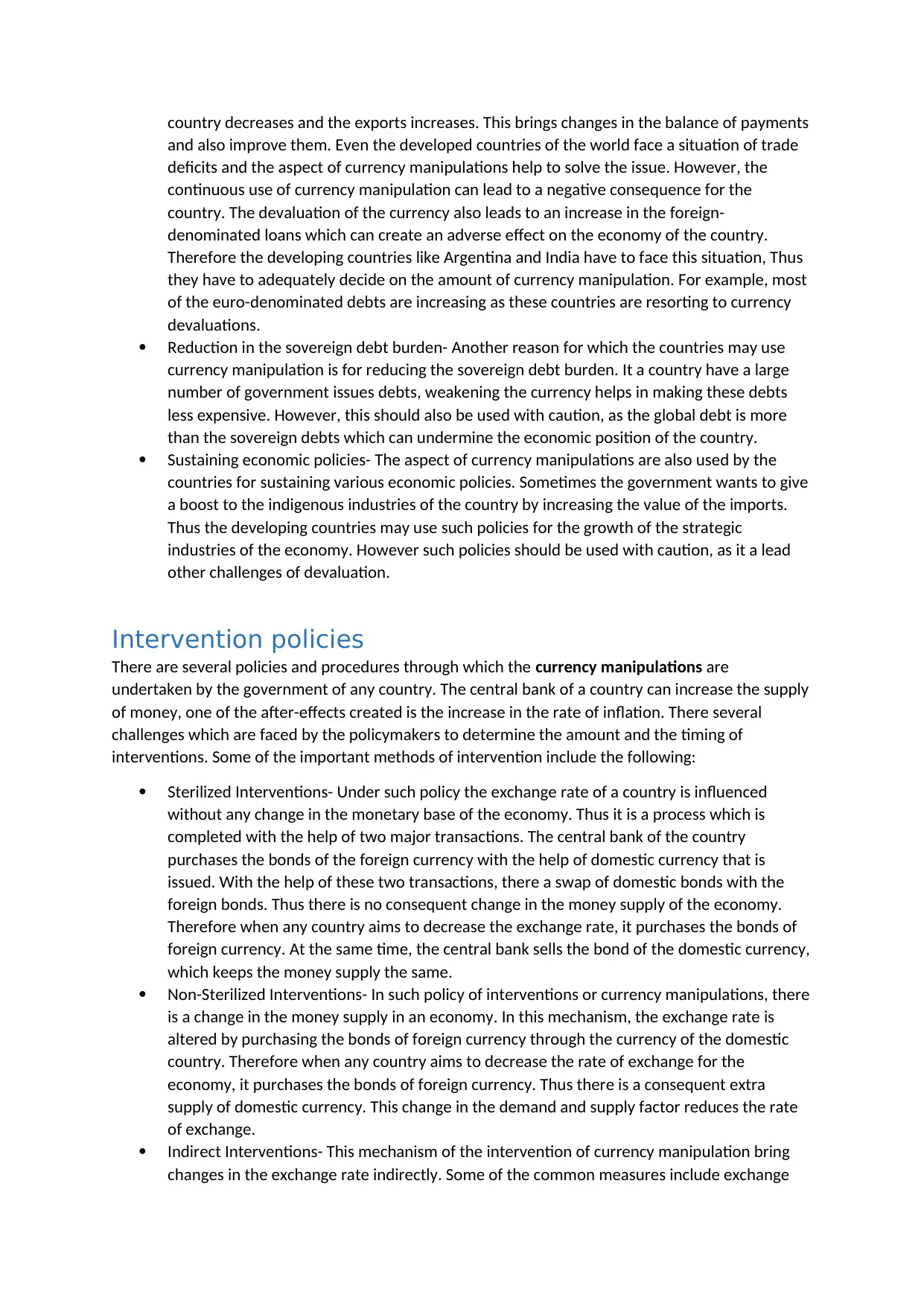
country decreases and the exports increases. This brings changes in the balance of payments
and also improve them. Even the developed countries of the world face a situation of trade
deficits and the aspect of currency manipulations help to solve the issue. However, the
continuous use of currency manipulation can lead to a negative consequence for the
country. The devaluation of the currency also leads to an increase in the foreign-
denominated loans which can create an adverse effect on the economy of the country.
Therefore the developing countries like Argentina and India have to face this situation, Thus
they have to adequately decide on the amount of currency manipulation. For example, most
of the euro-denominated debts are increasing as these countries are resorting to currency
devaluations.
Reduction in the sovereign debt burden- Another reason for which the countries may use
currency manipulation is for reducing the sovereign debt burden. It a country have a large
number of government issues debts, weakening the currency helps in making these debts
less expensive. However, this should also be used with caution, as the global debt is more
than the sovereign debts which can undermine the economic position of the country.
Sustaining economic policies- The aspect of currency manipulations are also used by the
countries for sustaining various economic policies. Sometimes the government wants to give
a boost to the indigenous industries of the country by increasing the value of the imports.
Thus the developing countries may use such policies for the growth of the strategic
industries of the economy. However such policies should be used with caution, as it a lead
other challenges of devaluation.
Intervention policies
There are several policies and procedures through which the currency manipulations are
undertaken by the government of any country. The central bank of a country can increase the supply
of money, one of the after-effects created is the increase in the rate of inflation. There several
challenges which are faced by the policymakers to determine the amount and the timing of
interventions. Some of the important methods of intervention include the following:
Sterilized Interventions- Under such policy the exchange rate of a country is influenced
without any change in the monetary base of the economy. Thus it is a process which is
completed with the help of two major transactions. The central bank of the country
purchases the bonds of the foreign currency with the help of domestic currency that is
issued. With the help of these two transactions, there a swap of domestic bonds with the
foreign bonds. Thus there is no consequent change in the money supply of the economy.
Therefore when any country aims to decrease the exchange rate, it purchases the bonds of
foreign currency. At the same time, the central bank sells the bond of the domestic currency,
which keeps the money supply the same.
Non-Sterilized Interventions- In such policy of interventions or currency manipulations, there
is a change in the money supply in an economy. In this mechanism, the exchange rate is
altered by purchasing the bonds of foreign currency through the currency of the domestic
country. Therefore when any country aims to decrease the rate of exchange for the
economy, it purchases the bonds of foreign currency. Thus there is a consequent extra
supply of domestic currency. This change in the demand and supply factor reduces the rate
of exchange.
Indirect Interventions- This mechanism of the intervention of currency manipulation bring
changes in the exchange rate indirectly. Some of the common measures include exchange
and also improve them. Even the developed countries of the world face a situation of trade
deficits and the aspect of currency manipulations help to solve the issue. However, the
continuous use of currency manipulation can lead to a negative consequence for the
country. The devaluation of the currency also leads to an increase in the foreign-
denominated loans which can create an adverse effect on the economy of the country.
Therefore the developing countries like Argentina and India have to face this situation, Thus
they have to adequately decide on the amount of currency manipulation. For example, most
of the euro-denominated debts are increasing as these countries are resorting to currency
devaluations.
Reduction in the sovereign debt burden- Another reason for which the countries may use
currency manipulation is for reducing the sovereign debt burden. It a country have a large
number of government issues debts, weakening the currency helps in making these debts
less expensive. However, this should also be used with caution, as the global debt is more
than the sovereign debts which can undermine the economic position of the country.
Sustaining economic policies- The aspect of currency manipulations are also used by the
countries for sustaining various economic policies. Sometimes the government wants to give
a boost to the indigenous industries of the country by increasing the value of the imports.
Thus the developing countries may use such policies for the growth of the strategic
industries of the economy. However such policies should be used with caution, as it a lead
other challenges of devaluation.
Intervention policies
There are several policies and procedures through which the currency manipulations are
undertaken by the government of any country. The central bank of a country can increase the supply
of money, one of the after-effects created is the increase in the rate of inflation. There several
challenges which are faced by the policymakers to determine the amount and the timing of
interventions. Some of the important methods of intervention include the following:
Sterilized Interventions- Under such policy the exchange rate of a country is influenced
without any change in the monetary base of the economy. Thus it is a process which is
completed with the help of two major transactions. The central bank of the country
purchases the bonds of the foreign currency with the help of domestic currency that is
issued. With the help of these two transactions, there a swap of domestic bonds with the
foreign bonds. Thus there is no consequent change in the money supply of the economy.
Therefore when any country aims to decrease the exchange rate, it purchases the bonds of
foreign currency. At the same time, the central bank sells the bond of the domestic currency,
which keeps the money supply the same.
Non-Sterilized Interventions- In such policy of interventions or currency manipulations, there
is a change in the money supply in an economy. In this mechanism, the exchange rate is
altered by purchasing the bonds of foreign currency through the currency of the domestic
country. Therefore when any country aims to decrease the rate of exchange for the
economy, it purchases the bonds of foreign currency. Thus there is a consequent extra
supply of domestic currency. This change in the demand and supply factor reduces the rate
of exchange.
Indirect Interventions- This mechanism of the intervention of currency manipulation bring
changes in the exchange rate indirectly. Some of the common measures include exchange
Paraphrase This Document
Need a fresh take? Get an instant paraphrase of this document with our AI Paraphraser
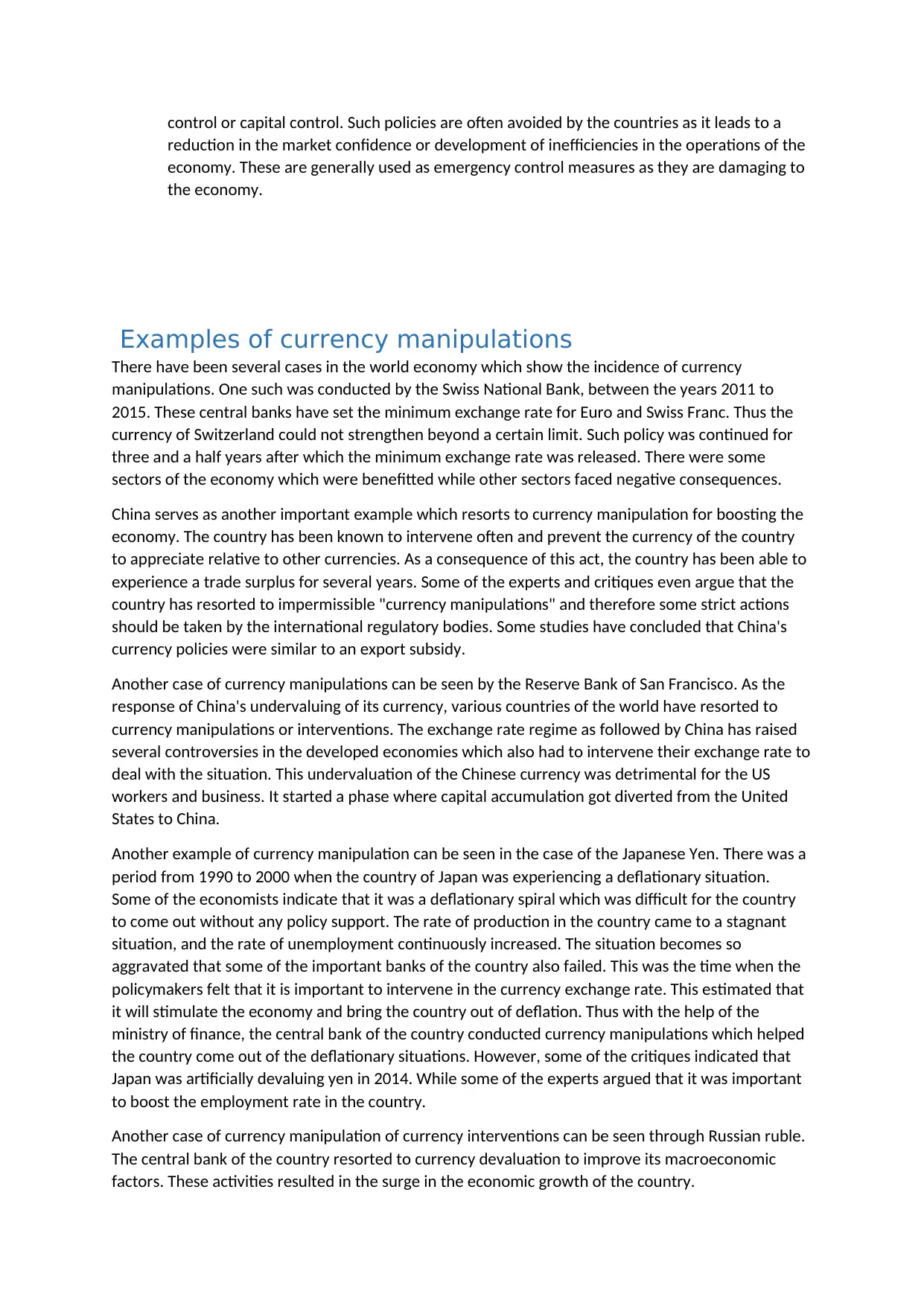
control or capital control. Such policies are often avoided by the countries as it leads to a
reduction in the market confidence or development of inefficiencies in the operations of the
economy. These are generally used as emergency control measures as they are damaging to
the economy.
Examples of currency manipulations
There have been several cases in the world economy which show the incidence of currency
manipulations. One such was conducted by the Swiss National Bank, between the years 2011 to
2015. These central banks have set the minimum exchange rate for Euro and Swiss Franc. Thus the
currency of Switzerland could not strengthen beyond a certain limit. Such policy was continued for
three and a half years after which the minimum exchange rate was released. There were some
sectors of the economy which were benefitted while other sectors faced negative consequences.
China serves as another important example which resorts to currency manipulation for boosting the
economy. The country has been known to intervene often and prevent the currency of the country
to appreciate relative to other currencies. As a consequence of this act, the country has been able to
experience a trade surplus for several years. Some of the experts and critiques even argue that the
country has resorted to impermissible "currency manipulations" and therefore some strict actions
should be taken by the international regulatory bodies. Some studies have concluded that China's
currency policies were similar to an export subsidy.
Another case of currency manipulations can be seen by the Reserve Bank of San Francisco. As the
response of China's undervaluing of its currency, various countries of the world have resorted to
currency manipulations or interventions. The exchange rate regime as followed by China has raised
several controversies in the developed economies which also had to intervene their exchange rate to
deal with the situation. This undervaluation of the Chinese currency was detrimental for the US
workers and business. It started a phase where capital accumulation got diverted from the United
States to China.
Another example of currency manipulation can be seen in the case of the Japanese Yen. There was a
period from 1990 to 2000 when the country of Japan was experiencing a deflationary situation.
Some of the economists indicate that it was a deflationary spiral which was difficult for the country
to come out without any policy support. The rate of production in the country came to a stagnant
situation, and the rate of unemployment continuously increased. The situation becomes so
aggravated that some of the important banks of the country also failed. This was the time when the
policymakers felt that it is important to intervene in the currency exchange rate. This estimated that
it will stimulate the economy and bring the country out of deflation. Thus with the help of the
ministry of finance, the central bank of the country conducted currency manipulations which helped
the country come out of the deflationary situations. However, some of the critiques indicated that
Japan was artificially devaluing yen in 2014. While some of the experts argued that it was important
to boost the employment rate in the country.
Another case of currency manipulation of currency interventions can be seen through Russian ruble.
The central bank of the country resorted to currency devaluation to improve its macroeconomic
factors. These activities resulted in the surge in the economic growth of the country.
reduction in the market confidence or development of inefficiencies in the operations of the
economy. These are generally used as emergency control measures as they are damaging to
the economy.
Examples of currency manipulations
There have been several cases in the world economy which show the incidence of currency
manipulations. One such was conducted by the Swiss National Bank, between the years 2011 to
2015. These central banks have set the minimum exchange rate for Euro and Swiss Franc. Thus the
currency of Switzerland could not strengthen beyond a certain limit. Such policy was continued for
three and a half years after which the minimum exchange rate was released. There were some
sectors of the economy which were benefitted while other sectors faced negative consequences.
China serves as another important example which resorts to currency manipulation for boosting the
economy. The country has been known to intervene often and prevent the currency of the country
to appreciate relative to other currencies. As a consequence of this act, the country has been able to
experience a trade surplus for several years. Some of the experts and critiques even argue that the
country has resorted to impermissible "currency manipulations" and therefore some strict actions
should be taken by the international regulatory bodies. Some studies have concluded that China's
currency policies were similar to an export subsidy.
Another case of currency manipulations can be seen by the Reserve Bank of San Francisco. As the
response of China's undervaluing of its currency, various countries of the world have resorted to
currency manipulations or interventions. The exchange rate regime as followed by China has raised
several controversies in the developed economies which also had to intervene their exchange rate to
deal with the situation. This undervaluation of the Chinese currency was detrimental for the US
workers and business. It started a phase where capital accumulation got diverted from the United
States to China.
Another example of currency manipulation can be seen in the case of the Japanese Yen. There was a
period from 1990 to 2000 when the country of Japan was experiencing a deflationary situation.
Some of the economists indicate that it was a deflationary spiral which was difficult for the country
to come out without any policy support. The rate of production in the country came to a stagnant
situation, and the rate of unemployment continuously increased. The situation becomes so
aggravated that some of the important banks of the country also failed. This was the time when the
policymakers felt that it is important to intervene in the currency exchange rate. This estimated that
it will stimulate the economy and bring the country out of deflation. Thus with the help of the
ministry of finance, the central bank of the country conducted currency manipulations which helped
the country come out of the deflationary situations. However, some of the critiques indicated that
Japan was artificially devaluing yen in 2014. While some of the experts argued that it was important
to boost the employment rate in the country.
Another case of currency manipulation of currency interventions can be seen through Russian ruble.
The central bank of the country resorted to currency devaluation to improve its macroeconomic
factors. These activities resulted in the surge in the economic growth of the country.
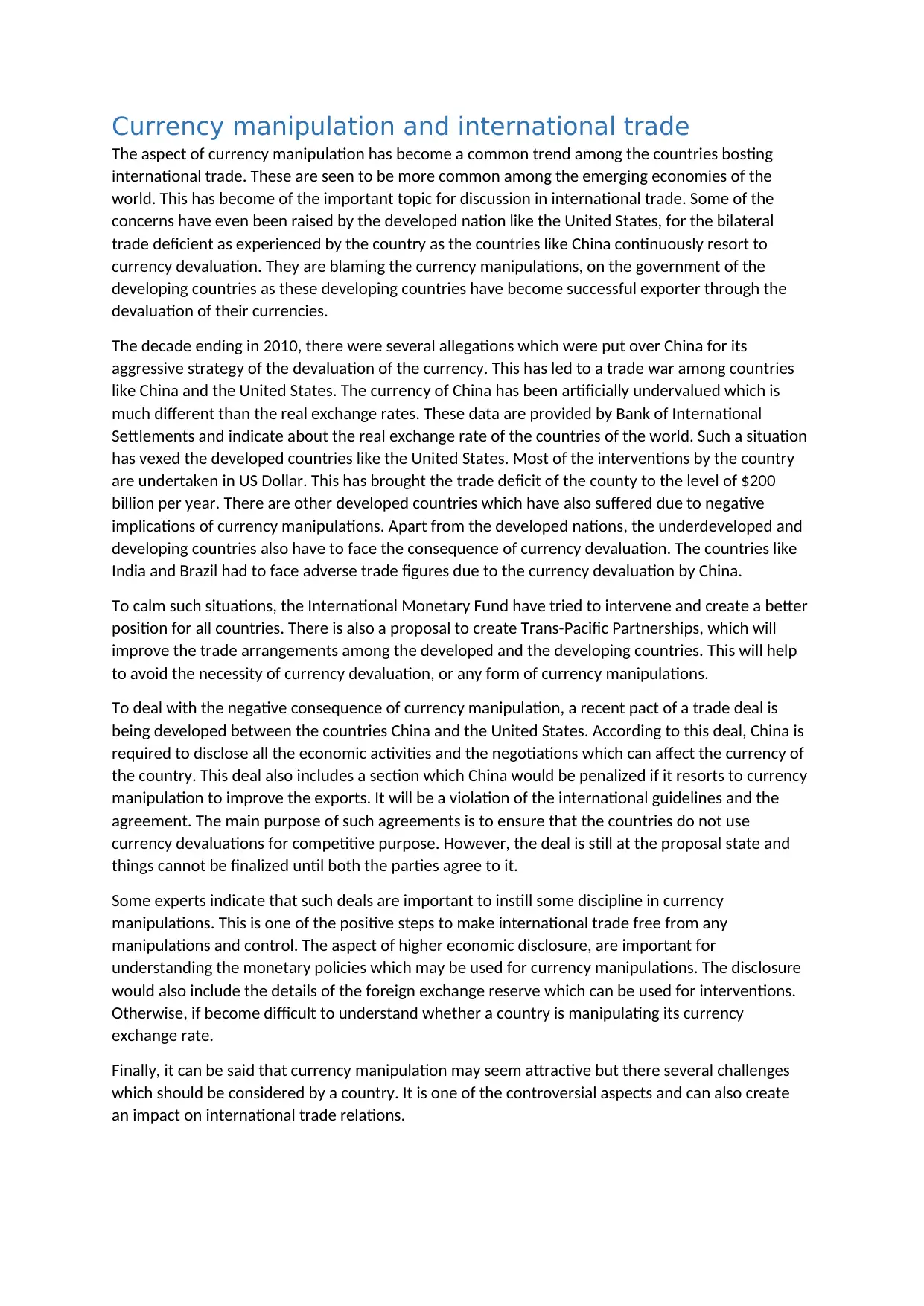
Currency manipulation and international trade
The aspect of currency manipulation has become a common trend among the countries bosting
international trade. These are seen to be more common among the emerging economies of the
world. This has become of the important topic for discussion in international trade. Some of the
concerns have even been raised by the developed nation like the United States, for the bilateral
trade deficient as experienced by the country as the countries like China continuously resort to
currency devaluation. They are blaming the currency manipulations, on the government of the
developing countries as these developing countries have become successful exporter through the
devaluation of their currencies.
The decade ending in 2010, there were several allegations which were put over China for its
aggressive strategy of the devaluation of the currency. This has led to a trade war among countries
like China and the United States. The currency of China has been artificially undervalued which is
much different than the real exchange rates. These data are provided by Bank of International
Settlements and indicate about the real exchange rate of the countries of the world. Such a situation
has vexed the developed countries like the United States. Most of the interventions by the country
are undertaken in US Dollar. This has brought the trade deficit of the county to the level of $200
billion per year. There are other developed countries which have also suffered due to negative
implications of currency manipulations. Apart from the developed nations, the underdeveloped and
developing countries also have to face the consequence of currency devaluation. The countries like
India and Brazil had to face adverse trade figures due to the currency devaluation by China.
To calm such situations, the International Monetary Fund have tried to intervene and create a better
position for all countries. There is also a proposal to create Trans-Pacific Partnerships, which will
improve the trade arrangements among the developed and the developing countries. This will help
to avoid the necessity of currency devaluation, or any form of currency manipulations.
To deal with the negative consequence of currency manipulation, a recent pact of a trade deal is
being developed between the countries China and the United States. According to this deal, China is
required to disclose all the economic activities and the negotiations which can affect the currency of
the country. This deal also includes a section which China would be penalized if it resorts to currency
manipulation to improve the exports. It will be a violation of the international guidelines and the
agreement. The main purpose of such agreements is to ensure that the countries do not use
currency devaluations for competitive purpose. However, the deal is still at the proposal state and
things cannot be finalized until both the parties agree to it.
Some experts indicate that such deals are important to instill some discipline in currency
manipulations. This is one of the positive steps to make international trade free from any
manipulations and control. The aspect of higher economic disclosure, are important for
understanding the monetary policies which may be used for currency manipulations. The disclosure
would also include the details of the foreign exchange reserve which can be used for interventions.
Otherwise, if become difficult to understand whether a country is manipulating its currency
exchange rate.
Finally, it can be said that currency manipulation may seem attractive but there several challenges
which should be considered by a country. It is one of the controversial aspects and can also create
an impact on international trade relations.
The aspect of currency manipulation has become a common trend among the countries bosting
international trade. These are seen to be more common among the emerging economies of the
world. This has become of the important topic for discussion in international trade. Some of the
concerns have even been raised by the developed nation like the United States, for the bilateral
trade deficient as experienced by the country as the countries like China continuously resort to
currency devaluation. They are blaming the currency manipulations, on the government of the
developing countries as these developing countries have become successful exporter through the
devaluation of their currencies.
The decade ending in 2010, there were several allegations which were put over China for its
aggressive strategy of the devaluation of the currency. This has led to a trade war among countries
like China and the United States. The currency of China has been artificially undervalued which is
much different than the real exchange rates. These data are provided by Bank of International
Settlements and indicate about the real exchange rate of the countries of the world. Such a situation
has vexed the developed countries like the United States. Most of the interventions by the country
are undertaken in US Dollar. This has brought the trade deficit of the county to the level of $200
billion per year. There are other developed countries which have also suffered due to negative
implications of currency manipulations. Apart from the developed nations, the underdeveloped and
developing countries also have to face the consequence of currency devaluation. The countries like
India and Brazil had to face adverse trade figures due to the currency devaluation by China.
To calm such situations, the International Monetary Fund have tried to intervene and create a better
position for all countries. There is also a proposal to create Trans-Pacific Partnerships, which will
improve the trade arrangements among the developed and the developing countries. This will help
to avoid the necessity of currency devaluation, or any form of currency manipulations.
To deal with the negative consequence of currency manipulation, a recent pact of a trade deal is
being developed between the countries China and the United States. According to this deal, China is
required to disclose all the economic activities and the negotiations which can affect the currency of
the country. This deal also includes a section which China would be penalized if it resorts to currency
manipulation to improve the exports. It will be a violation of the international guidelines and the
agreement. The main purpose of such agreements is to ensure that the countries do not use
currency devaluations for competitive purpose. However, the deal is still at the proposal state and
things cannot be finalized until both the parties agree to it.
Some experts indicate that such deals are important to instill some discipline in currency
manipulations. This is one of the positive steps to make international trade free from any
manipulations and control. The aspect of higher economic disclosure, are important for
understanding the monetary policies which may be used for currency manipulations. The disclosure
would also include the details of the foreign exchange reserve which can be used for interventions.
Otherwise, if become difficult to understand whether a country is manipulating its currency
exchange rate.
Finally, it can be said that currency manipulation may seem attractive but there several challenges
which should be considered by a country. It is one of the controversial aspects and can also create
an impact on international trade relations.
⊘ This is a preview!⊘
Do you want full access?
Subscribe today to unlock all pages.

Trusted by 1+ million students worldwide
1 out of 6
Related Documents
Your All-in-One AI-Powered Toolkit for Academic Success.
+13062052269
info@desklib.com
Available 24*7 on WhatsApp / Email
![[object Object]](/_next/static/media/star-bottom.7253800d.svg)
Unlock your academic potential
Copyright © 2020–2025 A2Z Services. All Rights Reserved. Developed and managed by ZUCOL.





